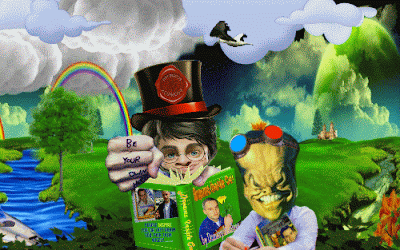Audio-Visual Stimuli-Giving Interaction Concepts:
1-
Audio-Visual Interactive Scenic Transformative Application (A-VISTA Concept);
2- Audio-Visual Associative Stimulation Triggering (A-VAST Concept).
The basics of A-VISTA
Concept consists in allowing spectator’s interacting with audio-visual content and performing
scenic-transformative manipulations such as, for an example, the followings-
(a)
changing alignment, size and colors of any
object or personage;
(b)
inserting
and animating personal photo-as-object (or any image) into selected scene and controlling actions of such newly-created personage integrated
into the plot episodes;
(c)
performing
series of chosen object’ activities causing the influence on other selected objects
actions;
(d)
creating
new scenes with newly-created objects, personages and background;
(e)
changing
episode and enhancing plot events according to personal preferences and creating
so called “self-personalized spin-off sub-story”.
The basics of A-VAST
Concept consist in allowing spectator’s visualizing associatively-generated
pictures and imaging phantomlike scenes resulting in stimulating an arousal of
pleasant feelings and emotions.
The audiovisual
stimuli-giving concept is generally based on utilization the caricature and fake images of world-famous people (e.g. celebrities) as a source of common, not-depending
on cultural and ethnic aspects, cognitive and mnemonic oxymora- illustrative associations visualized by applying various
pictorial methods and techniques elaborated by the Author.
The computer cartoon
animated scenes
are deliberately disrupting most traditional rules of painting
composition according to visual perception techniques and cognitive mnemonic
associative methods developed by the
Author. Based on using optical illusions pictorial art along
with various media spliced together, the audiovisual
stimuli-giving concept in its “visualization”
aspect employs a unique form of creating poster-like
motivational-inspirational and
artistically multi-layered animated scenes. The spectators are supposed to be
focused on the visual perception of events happening in the cartoon animation
thus for that reason, there are not much dialogues between characters or
personages whose personalities are
represented in allegories and metaphors that helps to understand what
really ‘drives’ each character.
ANNOTATION OF MAIN VISUALIZATION CONCEPTS
1) FAKED NEWS: “DOCUFICTION FT. DOCUFAKE”
Visualized
with the usage of the elements of satyr and parody, the scenes of “docufake” TV
Live “Faked X Naked News” (FXN) are purposed not only to entertain the
spectators but to educate the public about specific tricks used by criminals to
trap and “to harvest” their victims. The rhetoric insistently presses upon
the audience to read the lips-headed characters’ images in a certain fashion.
2) HINT-GIVING: “Oxymora Cognitive Mnemonic”
The
“oxymora” (or else “oxy-moron”) cognitive mnemonic (or else mnemo-technique)
visualization concept allows explaining the characters’ motivation-driven and
self-questioning actions.
This visualization concept, integrated
with “Science of Stupid VS. Science of Wisdom” visualization approach,
aims at allegorical and metaphorical mirroring of characters’ actions in their
dream-having scenes so the spectator will be given “a hint” about characters’
true motivation and “just another puzzle-piece” for the whole-story-puzzle.
3) "Breaking
News": Associative Memory Addressing Patterns
Stylized in the form of
"Breaking News" reporting announcements, at the certain extent this
visualization concept might be considered “predicted arguments” feeding into
the Author-branded theories as prophecies foreseeing some global-change events.
The Author gives his
prophecies not only to urge the public and catch the public-interest attention
to such prophecies interpreted as theories, but more than anything else to –
(1)
entertain
the audience with the specific “wisdomization thru visualization” form of
audiovisual content packed with symbolism, allegories and metaphors used to
represent paired-off-personages;
(2)
introduce
the audience into visual perception of “associative memory addressing patterns”
REMARK:
- Known in a public domain as
“associative memory patterns”, the term of “associative memory
addressing patterns” originally comes from “associative
cognitive mnemonics addressing patterns”, a complex term coined by the
Author to define a set of “cognitive mnemonic specimens” specific
graphic-making techniques and methods.
“Cognitive mnemonic specimens” presented in the form
of illustrations are basically used in conceptualization of (1) cognitive-optical illusions and multi-stable perceptual phenomena, and
(2) cognitive mnemonic oxymora and stratagem-stalking visualization method,
which altogether are applied to Author-elaborated prophetical
theory called “Dreams Inside Out”.
Characters’ imaging, scenes transitions and
VFX underlying concepts
VFX underlying concepts
(transitions and special video effects emulating 3D and stereopsis-enhanced environment);
2) “Celebrities‘ Caricatures and Pictures Faking”
(oxymoron cognitive mnemo-technique associative characters’ image-making);
3) “Real Actors’ Animated Scene Mounting” (real person’s appearance in cartoon animated scenes environment);
4)“Science of Stupid VS Science of Wisdom": Opt-illusions Brain-Gaming Visualization (the usage of opt-art and brain-game visual perception aiming at creating virtually emulated reality environment);
5) “Landscape Stretchung Stereopsis Enhancing”
(creating horizontal parallax-motion stereopsis-enhancing environment).
ANNOTATION OF AUTHOR-ELABORATED AUDIOVISUAL STIMULATION METHODS &
TECHNIQUES
1. “Dreams
Inside Out Scripting” is a method of turning audiovisual associations
into a variety of objects appeared as scenario-scripted role-playing characters
or personages to result in arousing pleasant and joyous positive feelings and
emotions.
2. “Visual
Digest Aspects” is a set of
author-elaborated “know-how” pictorial and graphic methods and techniques to be
used for creating scenario-scripted artworks with utilizing optical art
(optical illusions), multistable visual perceptual phenomena, cognitive
stratagem stalking modeling, and purposely breaking the traditional pictorial
(painting/image) composition rules.
3. “Audio
Digest Aspects” is a music-sound synestesia effect technique to create musical
compositions by applying various range of audio- filters, isochronal tones, pseudo- and
quasi-binaural sounds that leads to
the unusual additional experiences of hearing sounds that in its turn lead to
increased activation of brain regions involved in sound perception, thus
demonstrating their reality, and similarity to real sound percept.
4. “Oxymoronic
objects choreography & paradoxical oxymora antithesis visualization” is a set of
author-elaborated “know-how” pictorial and graphic methods that call visual
attention to an apparent contradiction (superficially scenes contradictory) of
objects in actions or non-actions but juxtaposed in such a way that there is no
contradiction and being deliberately intended to confuse and designed to
provoke a laugh.





